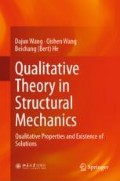Abstract
This chapter gives an introduction to the qualitative theory in Structural Mechanics, providing a brief history of its development, describing the content and methods of the study, and explaining the significance of the theory in research and application. In addition, this chapter presents main results of qualitative theory in Structural Mechanics covered in the book, which makes it easier for readers to select portions of the book for further study based on their personal need and interest.
Access this chapter
Tax calculation will be finalised at checkout
Purchases are for personal use only
References
Courant R, Hilbert D (1962) Methods of mathematical physics, vol I, 1953, vol II. Interscience Publishers, New York
Faber G (1923) Beweis, dass unter allen homogenen membranen van gleicher fläche und gleicher spannung die kreisfömige den tiefsten grundton gibt. S B Math-Nat KI Bayer Akad Wiss, 169–172
Gantmacher FP, Krein MG (1961) Oscillation matrices and kernels and small vibrations of mechanical systems. U. S. Atomic Energy Commission, Washington
Gladwell GML (2004) Inverse Problems in Vibration. 2nd edn. Springer, Dordrecht (1986, 1st edn, Martinus Nijhoff Publishers, Dordrecht)
Hu HC, Liu ZS, Wang DJ (1996) Influence of small changes of support location on vibration mode shape. Acta Mech Sin 28(1):23–32 (in Chinese)
Krahn E (1924) Uber eine von Raylegh formulierte minimaleigenschaft des kreises. Math Ann 1924(94):97–100
Leung AYT, Wang DJ, Wang Q (2004) On concentrated mass and stiffness in structural theories. Int J Struct Stab Dyn 4:171–179
Liu ZS, Hu HC, Wang DJ (1994) Effect of small variation of support location on natural frequencies. In: Proceedings of international conference on vibration engineering, ICVE’94, Beijing. International Academic Publishers, Singapore, pp 9–12
Liu ZS, Hu HC, Wang DJ (1996) New method for deriving eigenvalue rate with respect to support location. AIAA J 34(4):864–865
Pleijel A (1956) Remarks on Courant’s nodal line theorem. Comm Pure Appl Math 1956(4):543–550
Polterovich I (2009) Pleijel’s nodal domain theorem for free membranes. Proc Am Math Soc 137(3):1021–1024
Wang DJ, Hu HC (1982) A unified proof for the positive definiteness and compactness of two kinds of operators in the theory of elastic structure. Acta Mech Sin 14(2):111–121 (in Chinese)
Wang DJ, Hu HC (1982) A unified proof of the general properties of the linear vibrations in the theory of elastic structures. J Vibr Shock, 1(1):6–16 (in Chinese)
Wang DJ, Hu HC (1983) A unified proof for the positive-definiteness and compactness of two kinds of operators in the theories of elastic structures. In: Proceedings of the China-France symposium on finite element methods. Science Press China, New York, pp 6–16
Wang DJ, Hu HC (1985) Positive definiteness and compactness of two kinds of operators in theory of elastic structures. Sci Sin Ser A 28(7):727–739
Wang DJ, He BC, Wang QS (1990) On the construction of the Euler-Bernoulli beam via two sets of modes and the corresponding frequencies. Acta Mech Sin 22(4):479–483 (in Chinese)
Wang QS, Wang DJ (1987) Construction of the discrete system for the rod by partial natural modes and frequencies data. J Vibr Eng 1987(1):83–87 (in Chinese)
Wang QS, He BC, Wang DJ (1990) Some qualitative properties of frequencies and modes of Euler beams. J Vibr Eng 3(4):58–66 (in Chinese)
Wang QS, Wang DJ, He BC (1992) Qualitative properties of frequencies and modes of discrete system of continuous second-order systems. J Vibration and Shock, 11(3):7–12 (in Chinese)
Wang QS, Wang DJ (1994) An inverse mode problem for continuous second-order systems. In: Proceedings of international conference on vibration engineering, ICVE’94, Beijing. International Academic Publishers, Singapore, pp 167–170
Wang QS, Wang DJ (1997) Qualitative properties of frequency spectrum and modes of arbitrary supported beams in vibration. Acta Mech Sin 29(5):540–547 (in Chinese)
Wang QS, Huang PC (2008) The influence for the frequency of beams by adding internal support. Mod Vibr Noise Technol 6:104–107
Zheng ZJ, Chen P, Wang DJ (2013) Oscillation property of the vibrations for finite element models of Euler beam. Qtr J Mech & Appl Math, 66(4):587–608
Zheng ZJ (2014) The qualitative vibrational property and modal inverse problems of rods and Euler beams [D]. Department of Mechanics and Engineering Science, College of Engineering, Peking University (in Chinese)
Author information
Authors and Affiliations
Corresponding author
Rights and permissions
Copyright information
© 2019 Springer Nature Singapore Pte Ltd. and Peking University Press
About this chapter
Cite this chapter
Wang, D., Wang, Q., He, B. (2019). Overview. In: Qualitative Theory in Structural Mechanics. Springer, Singapore. https://doi.org/10.1007/978-981-13-1376-9_1
Download citation
DOI: https://doi.org/10.1007/978-981-13-1376-9_1
Published:
Publisher Name: Springer, Singapore
Print ISBN: 978-981-13-1375-2
Online ISBN: 978-981-13-1376-9
eBook Packages: EngineeringEngineering (R0)

